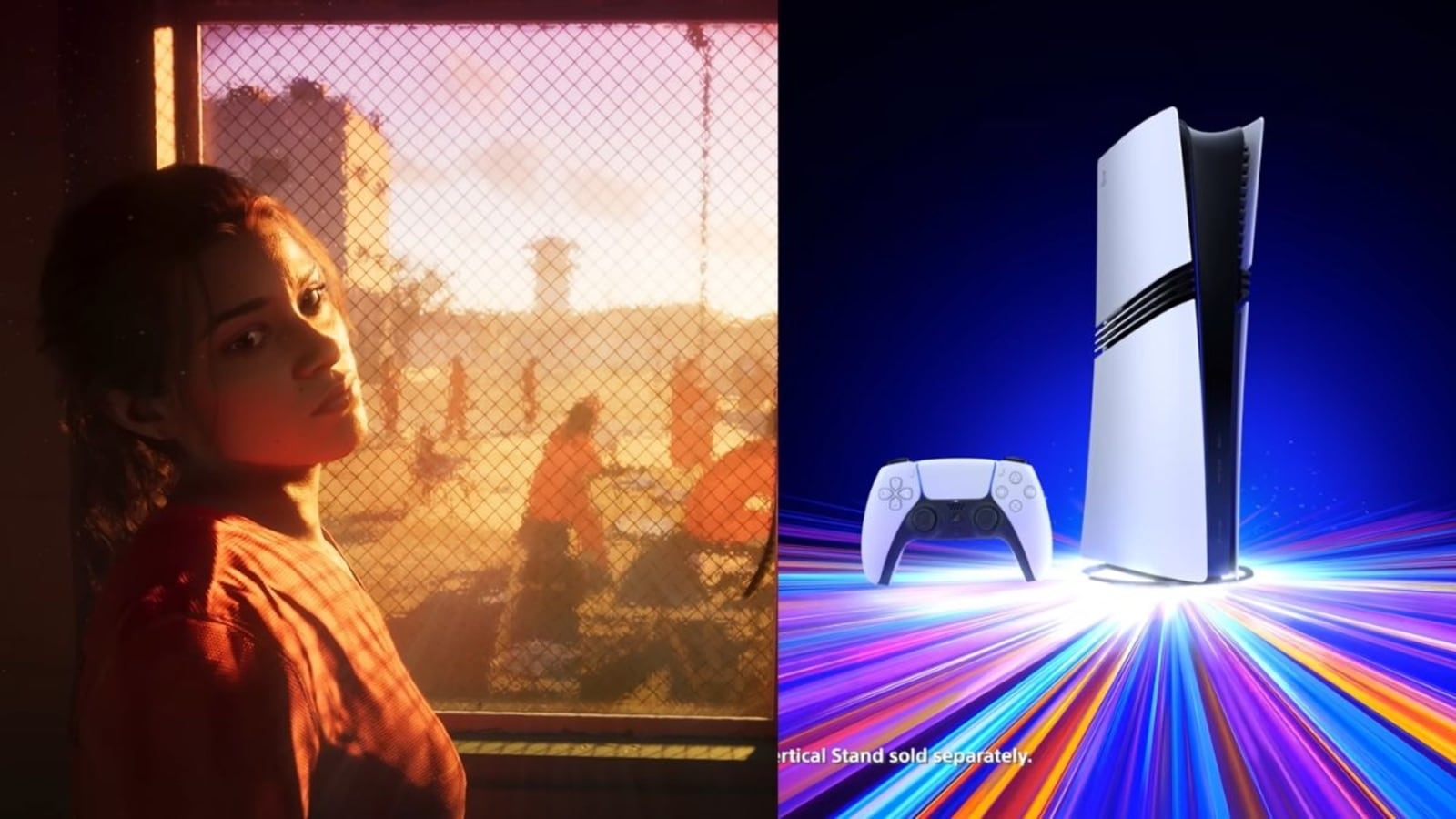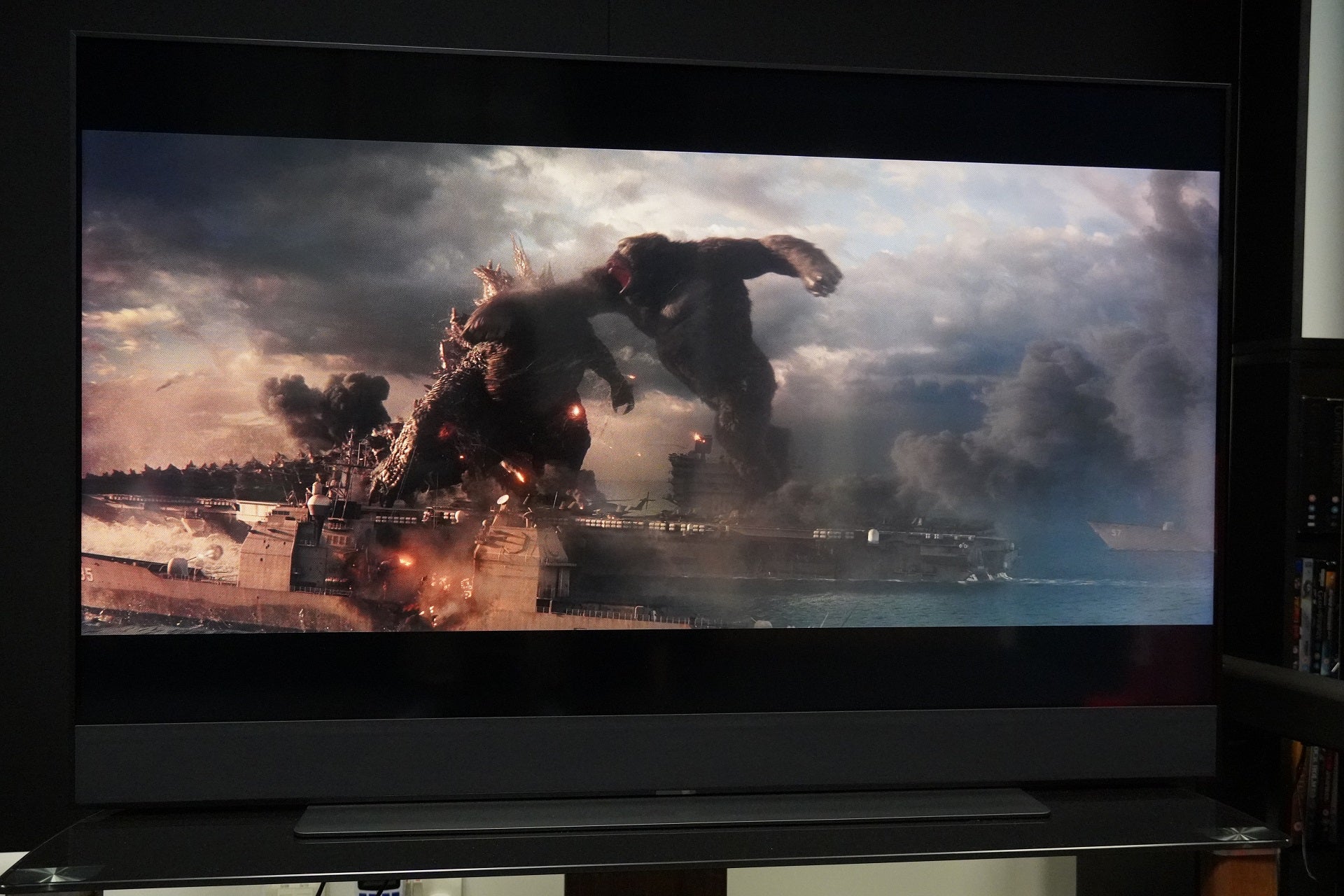Consider Sky Glass for what it is rather than what it’s not and there’s a good experience to be had. It’s not a TV for all people, though, a bit pricey for what it is, and the picture quality rather undermines its ambitious content plans.
Pros
- Great content library
- Better sound than TVs at its price
- Stylish looks
- Playlist is a cool idea
Cons
- Not for everyone
- HDR performance is underwhelming
- Subscriptions can build up in price
- Needs plenty of bandwidth for all the features
-
Sky Stream puckTransfers the Glass interface to another screen in the home -
SoundBuilt-in Dolby Atmos speaker system -
HDR supportHLG, HDR10 and Dolby Vision
Introduction
Sky Glass has been out for over a year, and after the hype that greeted its launch, Sky’s first TV has turned out to be one that’s still finding its footing.
It’s a TV designed to be easily digestible, smoothing out the rough edges of the TV buying experience by taking care of picture, sound, and content without need for additional soundbars, set-top boxes or streaming sticks.
But its performance was mixed with an average image quality the sorest issue as the screen failed to take advantage of all the 4K HDR content the Sky platform offered.
Sky have peppered Glass with updates to improve all aspects of its performance. Is it now a better option in 2022 than it was in 2021?
Availability
- UKRRP: £849
- USAunavailable
- Europeunavailable
- Canadaunavailable
- Australiaunavailable
Sky Glass can be purchased directly from Sky in 43-, 55- and 65-inch options. The TV can be bought outright (£649, £849 and £1049); or on a monthly basis in 24- and 48-month instalments.
Prices as of November as low as £11/month + £25 for Sky TV and Netflix on a 48-month contract for the small size.
In terms of add-ons, customers can choose from the Ultra HDR and Atmos package to Sky Sports, Sky Cinema, multi-room, the Sky Stream puck and more. Though the costs rise up even more if you do. You can read more about the packages here.
Design
- Big and heavy
- Minimalist looks
- Several colour options
Viewed from head-on Sky Glass looks elegant. With its minimalist stand, thin bezel trim, anodised finish, and acoustic mesh speaker grille, it has an understated, classy appearance.
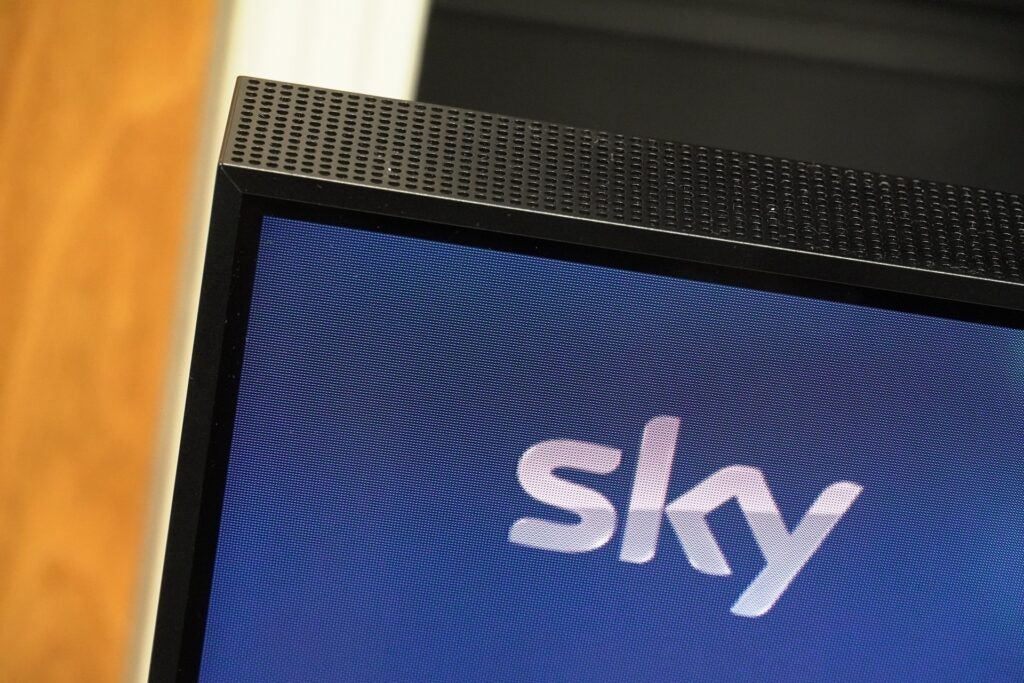
Viewed from an angle and the illusion shifts. The Glass is a hefty unit with a depth of 477mm. The 55-inch model weighs 28kg with the stand, so it’s a relief that installation is performed by the courier service. Shift it on your own and you might put your back out and a solid surface to plant this set on is a must.
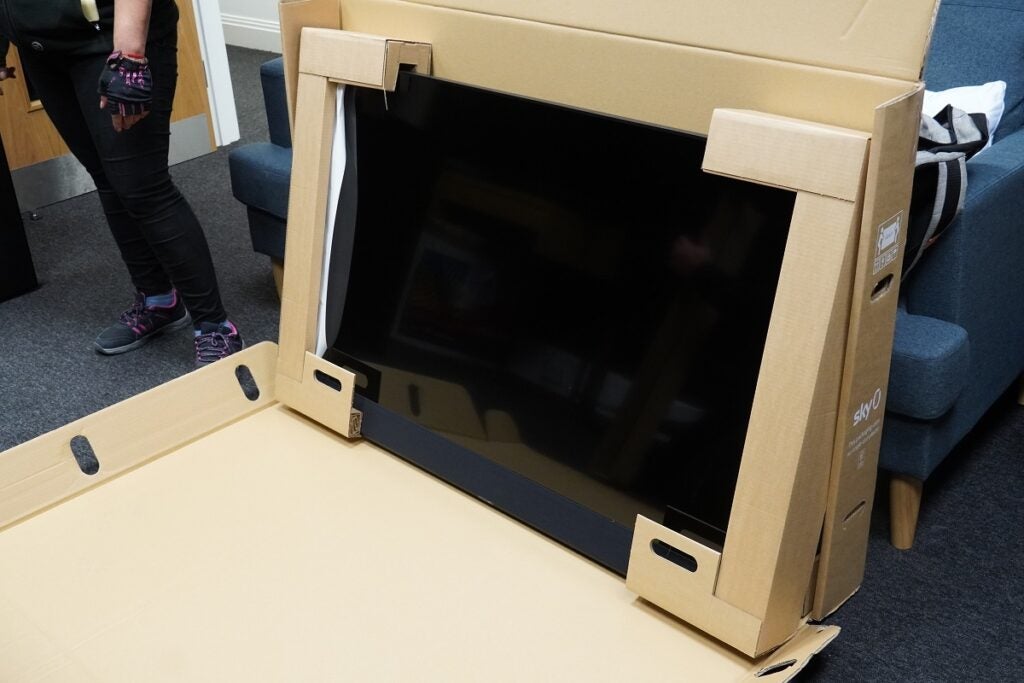
Irrespective of its dimensions, it has attracted admiring glances from the Trusted Reviews’ team. The review sample is the black Anthracite version, but Sky Glass brings colour to a living room with a choice of Ocean blue, Ceramic white, Racing green and Dusky pink to match your décor.
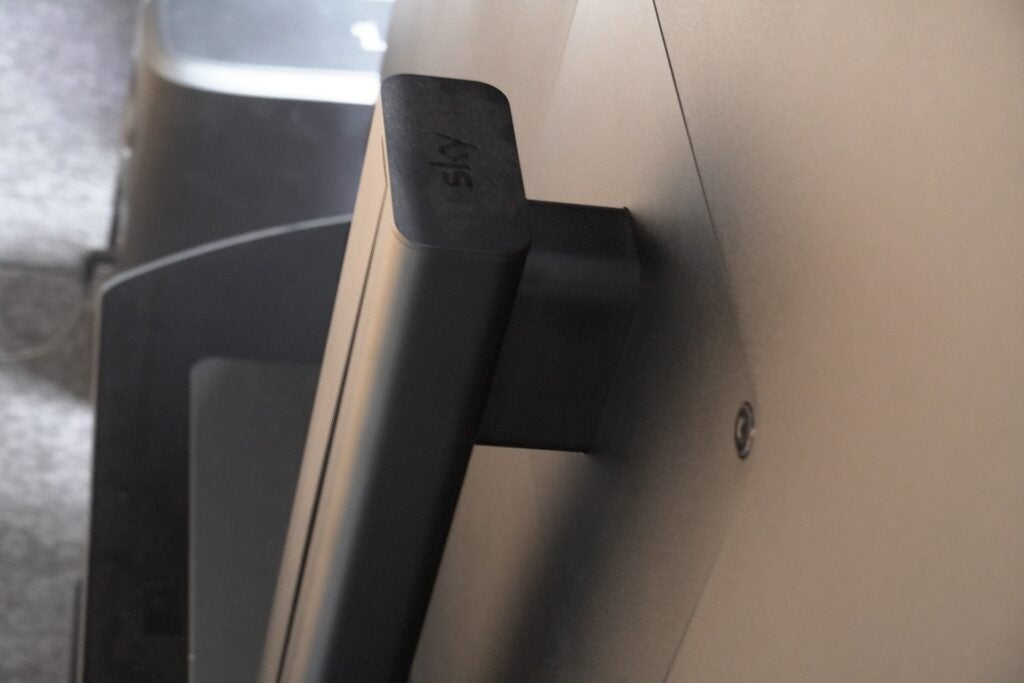
The speaker grille area can be customised with magnetised attachments, which can be purchased from Amazon seller Concino Limited (£39.99 to £59.99 depending on the size).
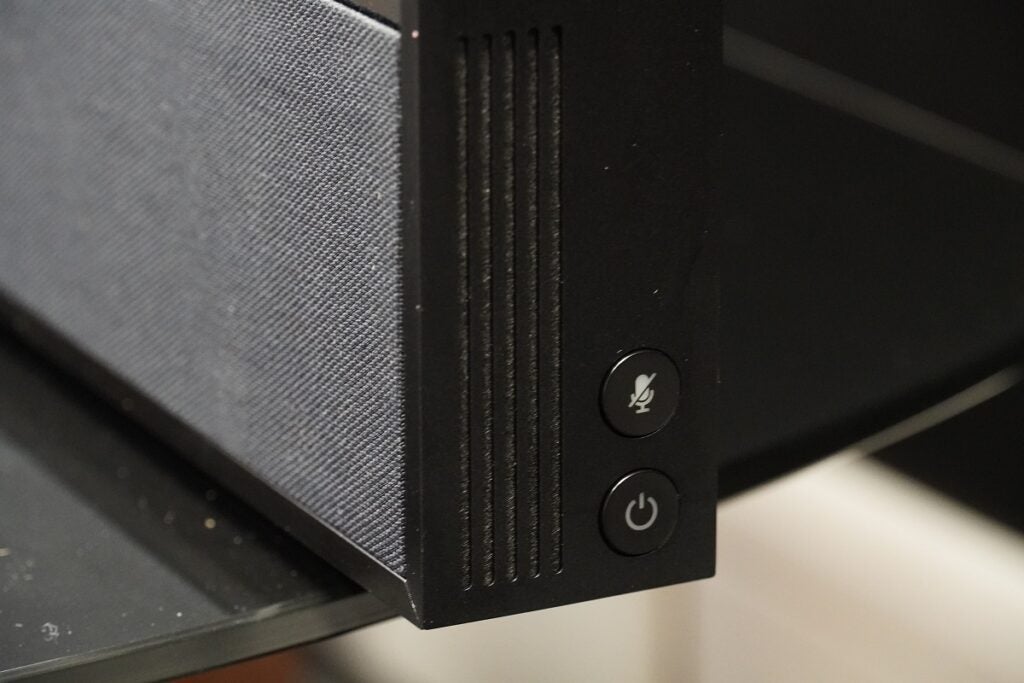
On the right-hand side are two buttons, one for disabling the TV’s far-field microphones and another for power. Cast your eyes to the top and there’s a perforated acoustic grille to disperse the sound from the upfiring speakers, while around the rear there’s a stanchion to keep the TV upright. If you want to wall-mount, give Sky a call and they’ll do it for you.
Interface
- Playlist collates saved content
- Easy to use interface
- Sky’s voice control solution
The Entertainment OS, as it’s now dubbed as, aggregates all that Sky has to offer alongside content from other providers. It uses the same rail navigation system as Sky Q, with the top rail offering quick access to recently used apps, inputs and spotlighted content in Top picks.
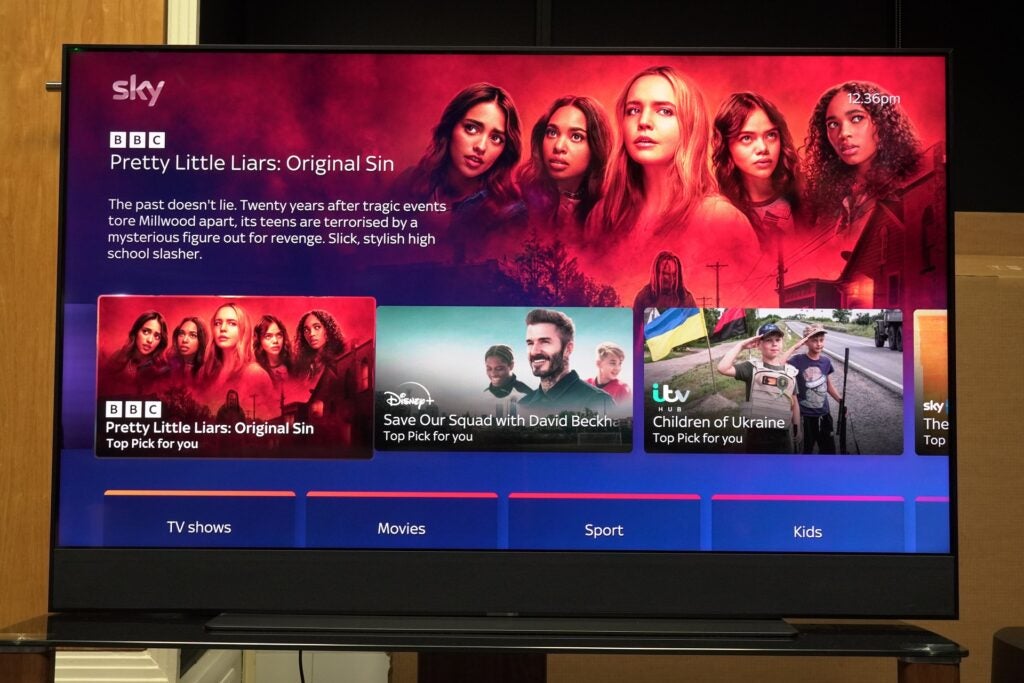
Below is a rail divided into TV Shows, Movies, Sport, Kids, Audio and Music, News, Fitness and International. Each section has a consistent look with content listed in rows and TV guides TV guides specific to each one. The breadth of content impresses, as does the way it’s been knitted together in a coherent, easy to decipher manner.
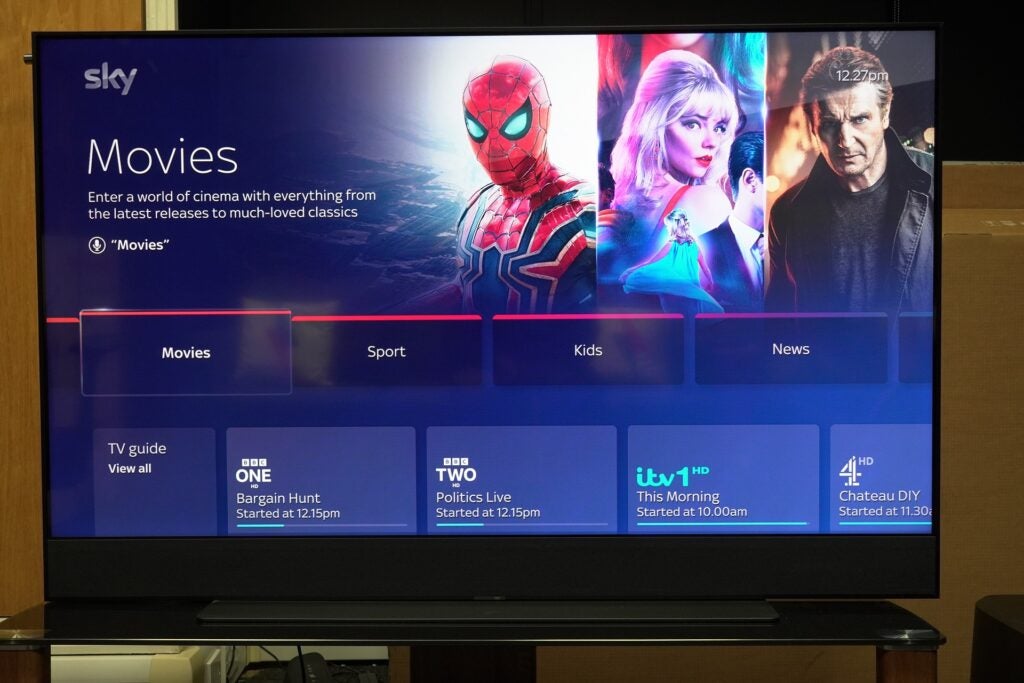
Most Sky Q apps make their way over, and while the number of apps is fewer than other TV smart portals, there’s something to be said about quality over quantity. Since Sky Glass launched its added Apple TV+, NBCUniversal’s Peacock, Paramount+ and LionsGate+.
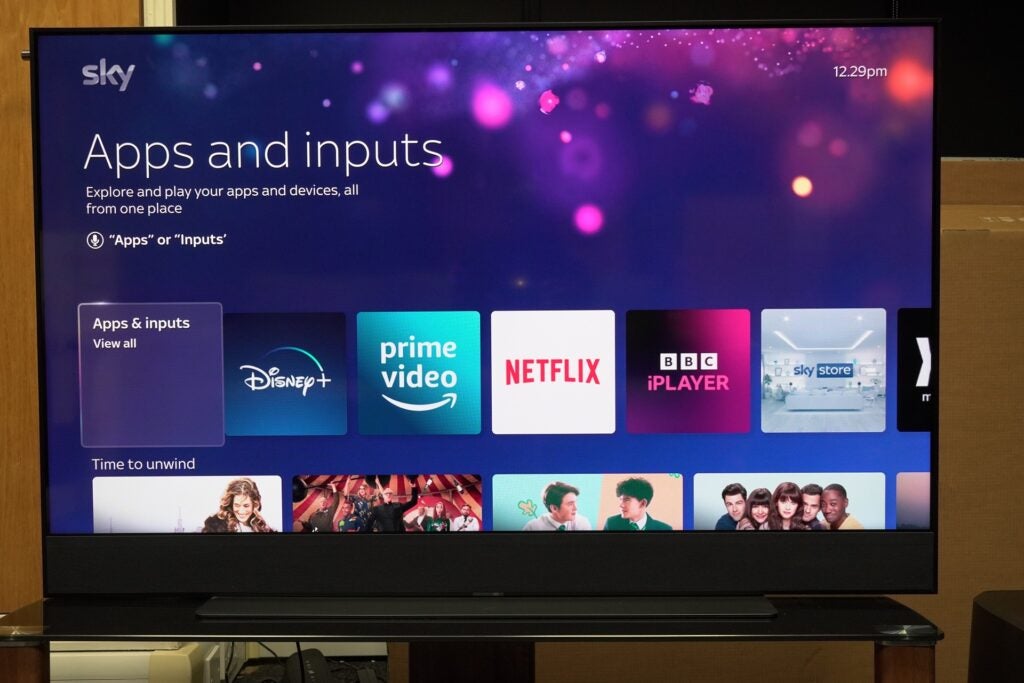
There’s plenty to discover and flicking through the rails with the remote is swift enough in terms of response. If you don’t want to use your digits, there’s built-in voice control that’s initiated by the words ‘Hello Sky’. Initially voice control was flaky, acting like a surly teenager with its lack of responsiveness but it’s become faster and more receptive since launch.
Voice support has been added to YouTube and Netflix so users can speak into the remote to find what they what, with Sky also saying that voice updates will be coming to more apps (although it has stated when and which apps).
Search results have also improved. In the beginning, a search for John Wick also conjured up Escape Route, Danny and Passenger to London – now it’s more specific with John Wick and John Wick: Chapter 2 are the results served up.
Voice commands via the remote’s near-field mic don’t require the ‘Hello Sky’ prompt, and in general, voice control gets you to where you want to go or to what you’re looking for. At a loss for what to watch? Say “What should I watch?” and you’re served rows of recommended content.
The remote itself is a neat affair with a rubbery texture for a grippy hold and backlit buttons for use in the dark. It attracts fingerprints and smudges, but they’re easily wiped off.
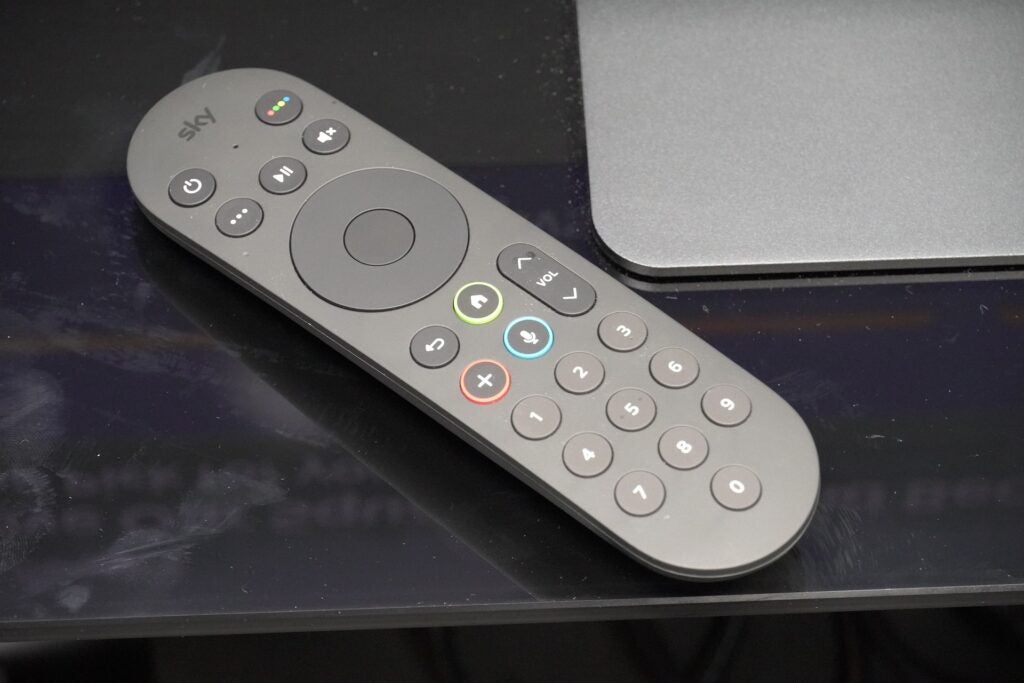
Sky refers to its Playlist feature as cloud DVR, but this has caused a degree of consternation as you can’t record content. It works by collating all the content you’ve watched, are watching and plan to watch, and in that context it’s a great way to keep track of shows and films. It’s had a few re-jigs over the year, with movies, TV shows and sports now separated to their own rows.
However, for those who like to keep a permanent file, that’s simply not possible due to rights issues. Once a programme has left Netflix, for example, access to that programme will disappear from your Playlist.
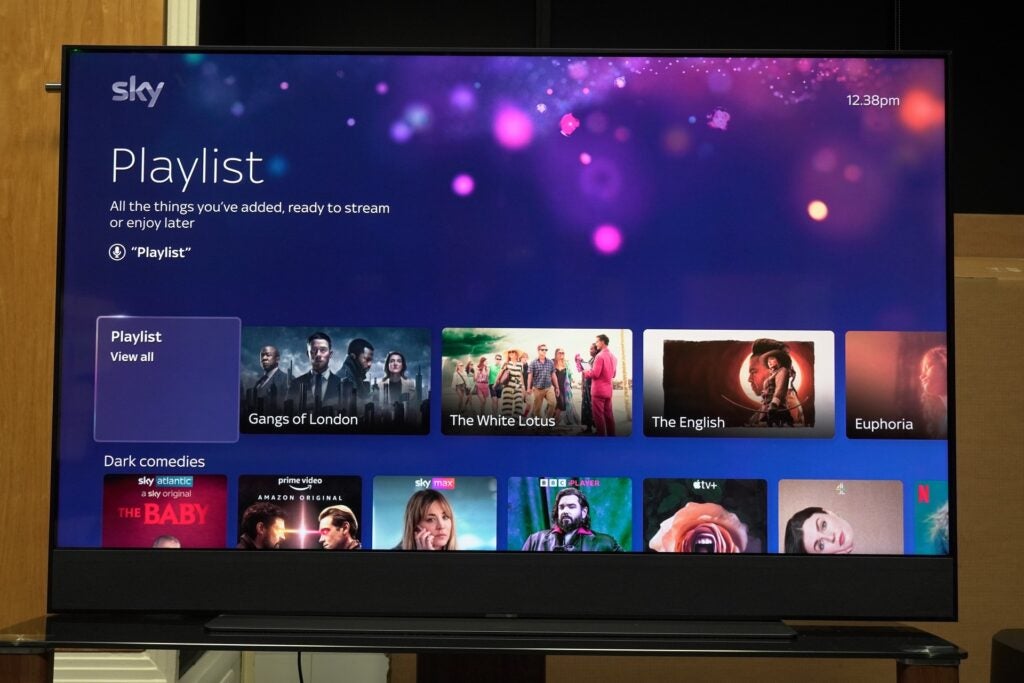
Sky’s counterargument is that nothing truly disappears, instead it migrates to another service but the obvious issue you encounter there is that what if it appears on Prime Video and you don’t have an account? Do viewers want, or have the desire, to create an account for a service they don’t already watch? Would they necessarily want to pay for it on Sky Store when it was part of their subscription on another service? One answer is to simply wait for the programme to come back, but then that puts a few holes into Sky’s seamless approach to aggregating content.
You can’t add content directly from apps so a search must be performed, and you can add there, or if you happen to come across something interesting then a press of the ‘+ button on the remote adds it to your Playlist. It’s nice and straightforward to do.
Add a TV series to Playlist and it’ll string together all the seasons, regardless of the apps it’s spread over and with Sky adding its store if it’s not available elsewhere then the Sky Store can fill the gap.
There are no individual profiles but personalised Playlists for different family members are in the offing so you can view what you want rather than have to filter through your kid’s tastes. Currently the home page refreshes content six times a day. If a child watches in the morning, and a parent at night, it’ll reflect those times in the programming served up.
Sky has brought its accessibility features over to Glass, incorporating the High Contrast interface, Audio description and highlighting of content in the TV Guide for easier recognition.
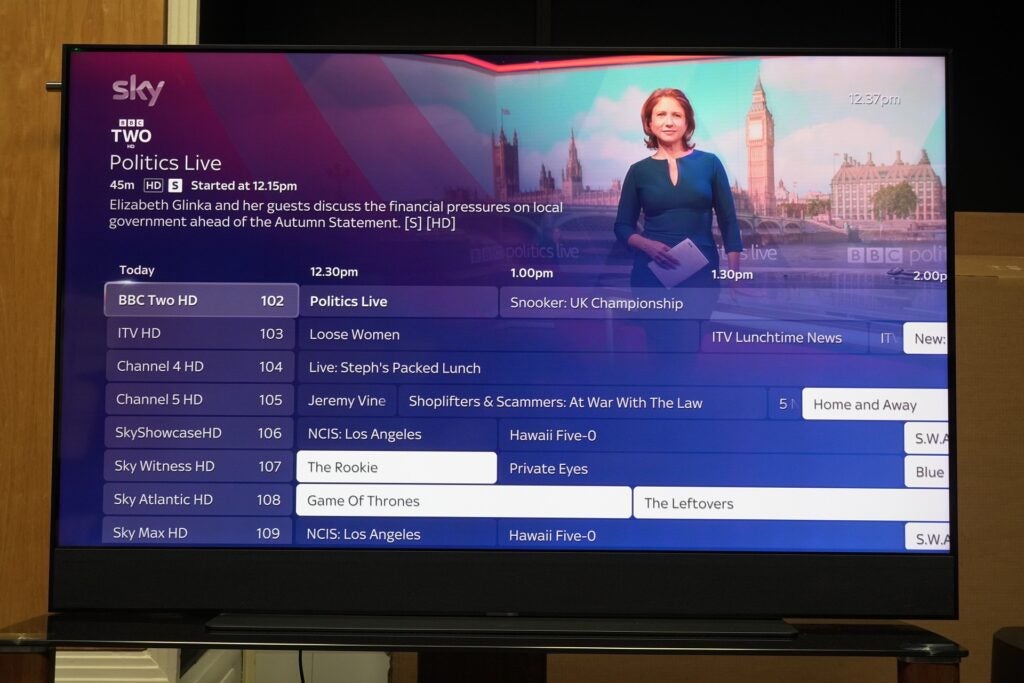
Features
- Not for gamers
- Minimum 10Mb/s for streaming
- Stream puck copies interface to other screens
There are things that Sky Glass is, and things that it’s not – and it’s not a gaming TV. With no game mode, latency is a measly 66ms and with no Auto Low Latency Mode, 4K/120fps or Variable Refresh Rate, Sky Glass isn’t looking to play in that gaming sandpit.
The three HDMI inputs support the HDMI 2.1 spec, with HDMI 2 the eARC port for pass-through of higher quality audio to an external sound system. As Sky Glass has a built-in Atmos sound system, you could leave it at that if you wanted.
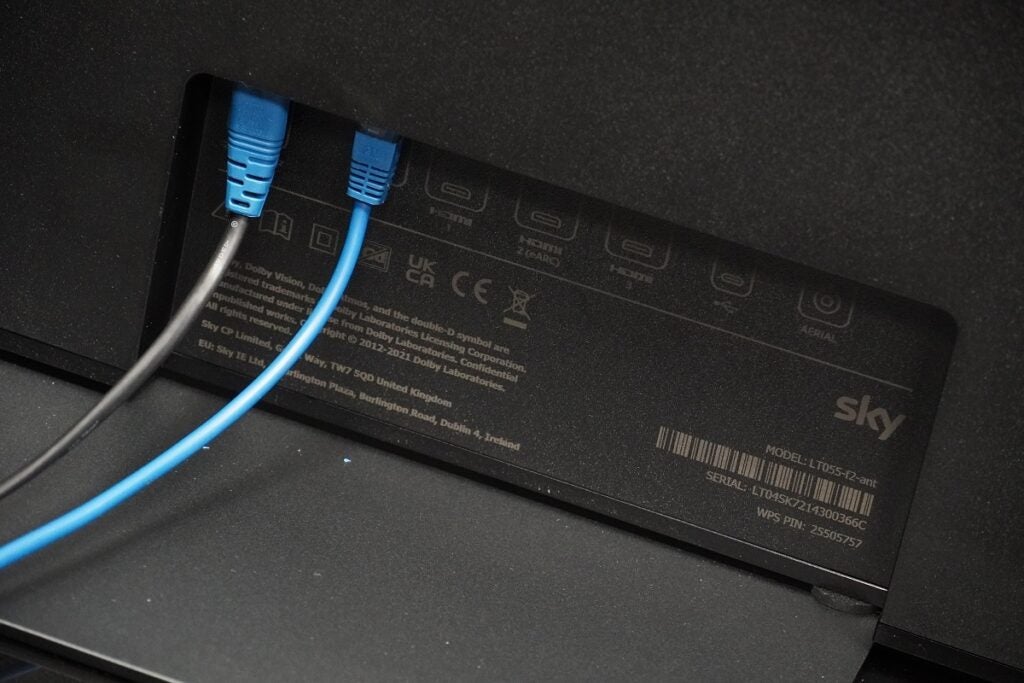
Other connections include USB-C, Ethernet, and a DTT DVB-T/T2 aerial. That offers basic Freeview and acts as a backup in case the Internet goes down. There’s Bluetooth 5.0 (for the remote, general Bluetooth connectivity is arriving soon) and Wi-Fi 6. Sky Glass requires a minimum speed of 10Mb/s (25Mb/s for 4K Ultra HD).
During start-up you’re given a choice of Default or Enhanced experiences. Enhanced activates voice control and the instant wake-up features, so the TV can be turned on via voice or by shuffling past, though the latter feature is not the most consistent in behaviour.
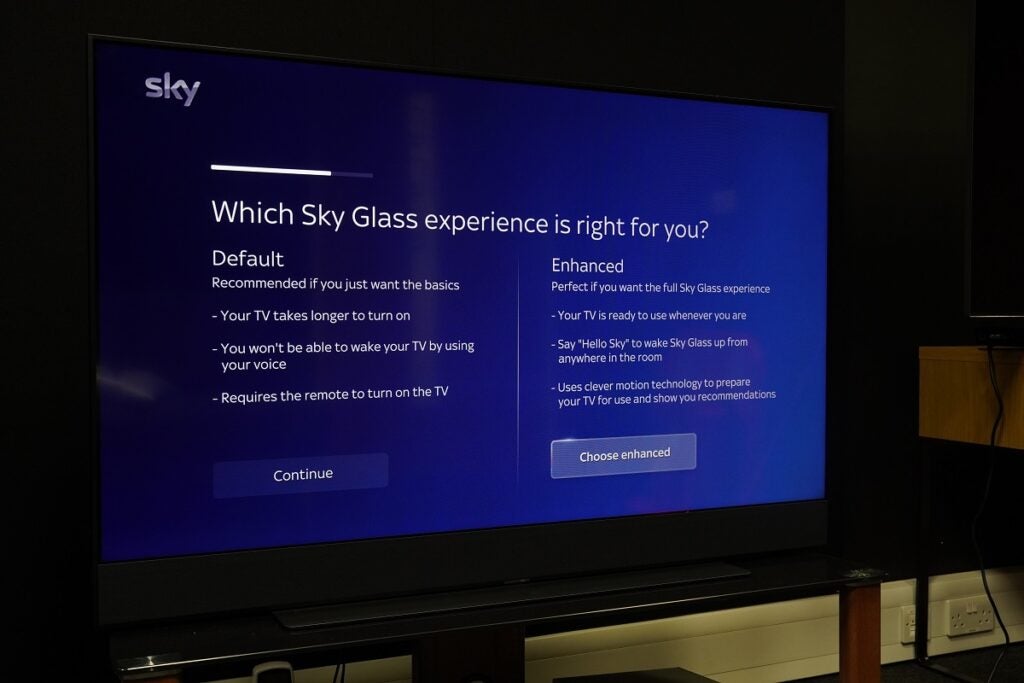
More times than I can count I’ve walked past, and nothing has happened. Other times I’ve absentmindedly walked by to find it’s woken up. Waking it with your voice is more consistent and since launch has become quicker in the time it takes to boot.
I wasn’t supplied with the Sky Stream puck for review but that works independently of Glass and is now available to buy as a standalone device fi you have an existing TV and just want to stream content from Sky. Stream uses around 15Mb/s to stream content within the home.
Picture Quality
- Underwhelming HDR performance
- Lacks brightness
- Lacklustre viewing angles
Picture quality from Sky Glass is no disaster – it’s simply fine – but it’s not unreasonable to expect better.
The HDR performance suffers from a lack of brightness, with the 55-inch model producing a peak luminance of 430 nits, which is not quite at the level needed to realise the potential of HDR. Highlights – the brightest part of the image – are dimly rendered whether in HDR10 or Dolby Vision.

While watching A 4K Dolby Vision presentation of John Wick: Chapter 3 – Parabellum, the scene where Wick faces off against two shinobi assassins depicts contrast that’s mildly described and a picture somewhat two-dimensional in scope. Watching Netflix, even the lights in the background of Seinfeld’s stand-up sets lack brightness.
Dolby Vision Bright mode ekes out more brightness, while the Dark profile provides better blacks. But even with Dolby Vision, when Wick visits Angelica Huston’s The Director, there’s visible blooming.
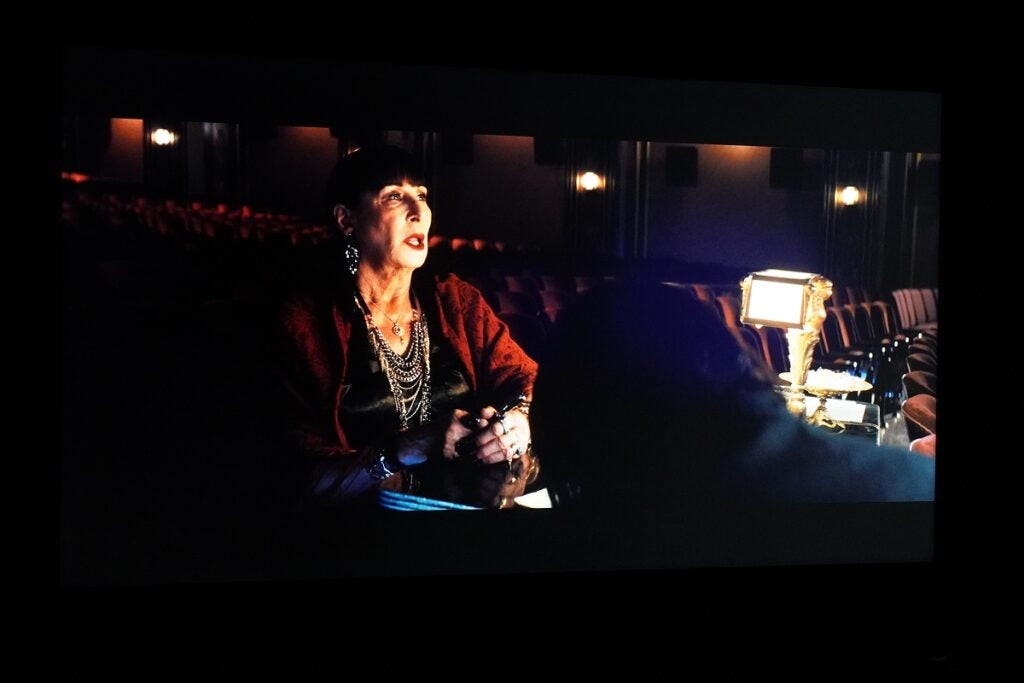
Watching House of the Dragon and black levels lack much in terms of depth, colours appear washed out and while there’s some three-dimensional depth to some images from the first episode of the season, the lack of contrast and richness to the colours make for an underwhelming experience.
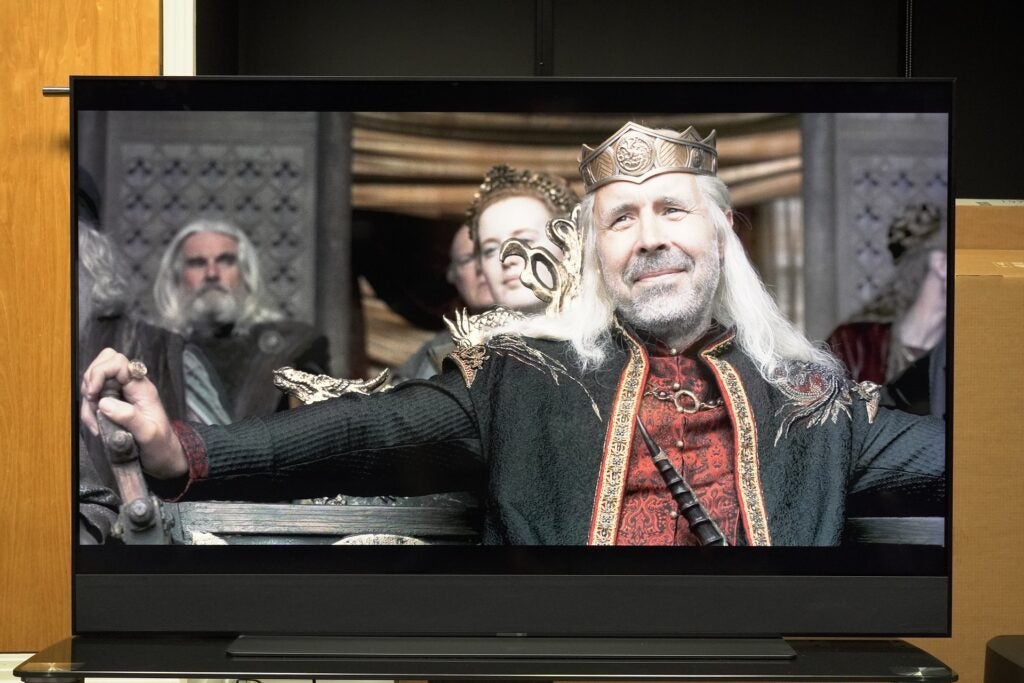
More brightness can be found by turning off the light sensor, but it’s disappointing to resort to that. I’m not all that convinced by Sky’s Intelligent Zonal Technology’ local dimming system as it seems to have little impact. Apparently, it’s been updated to be more aggressive, but there’s not much brightness to emphasise contrast.
For a Quantum Dot panel, there’s a surprising lack of punchiness, saturation and expressiveness to HDR colours. When Luv visits Wallace in Blade Runner 2049, the orange glow of his chamber is wanly described, the colour gradations lack finesse. Fine tuning is required to get more out of the image.

A watch of Spurs against United in 4K HLG HDR, and though colours are firmer and more naturally conveyed than the HD presentation, the whites of the Spurs’ player shirts lacked the gleam and brightness I’d expect. Sky has released an update to boost HLG brightness, but overall, there’s a reserved feel to this TV’s HDR skills.
A strength of LCD TVs is dark detail and Sky Glass handles that aspect well enough for a revealing picture, though this is more apparent with brighter images. Black uniformity is fine, avoiding a washed-out appearance and ascribing a decent level of depth. However, with every bit of praise there’s a caveat. Viewing angles are average and it doesn’t take a big shift off-axis to reveal washed out colours and blooming, not helped by TV not dealing particularly well with reflections and glare from within a room.

HD streaming is decent, but like the story of Sky Glass’ picture, it’s up and down. At times sharp and clear enough to pick out fine detail, in others it produces a softness to faces, as well as hardness and shininess to edges that distracts. Reducing sharpness helps but finding a middle ground is tricky. Motion handling isn’t the most adept either, with a slight blurriness noticeable even when people turn their heads
The content on Sky Glass is great, but its picture performance does not wring the best out of it. There is an update that looks to have fixed some (but not all) of its issues. Expect that to arrive before the end of 2022.
Sound Quality
- Decent, punchy bass for a TV
- Polite impression of height channels
- A soundbar would offer better focus
The audio system derives more enjoyment. The first sample had a faulty woofer that caused distortion with the mildest of low-end frequencies, but the replacement was free from issues.
Sky Glass’ 215W Dolby Atmos system is made up of six speakers: three that fire towards the listener, two that fire up and a woofer for the low frequencies. It’s an improvement over TVs in its price bracket, putting in a solid, weighty, and spacious presentation. Is it better than a budget soundbar? No, but this 2.1 system will suffice for the less demanding.
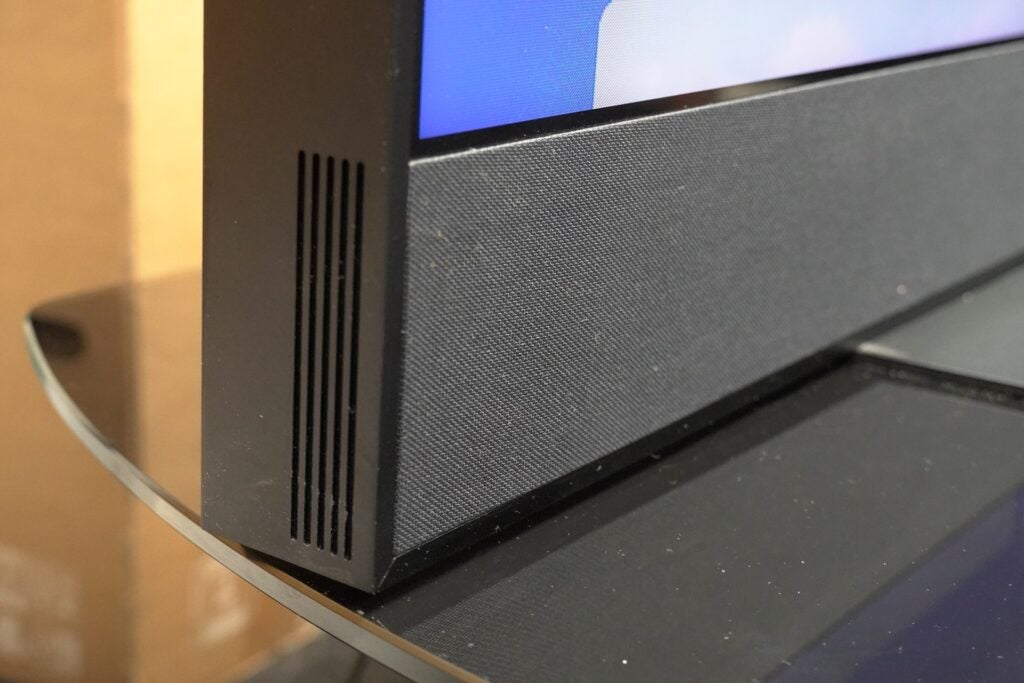
Vocals are emphasised, though not quite naturally, especially when two voices speak at once. Pump up the volume and voices have a sharp sense of tone but avoid sibilance. The effect of the Enhance Speech Quality setting is most evident on Sky content, with voices more prominent but the naturalness of the delivery a little stifled.
Effects are steered across the screen well, creating a soundfield that spreads beyond the TV’s four corners. The scene in Tenet where The Protagonist is interrogated in a train yard as the trains creak past and the width of the soundstage is effectively expanded beyond the TV’s borders.
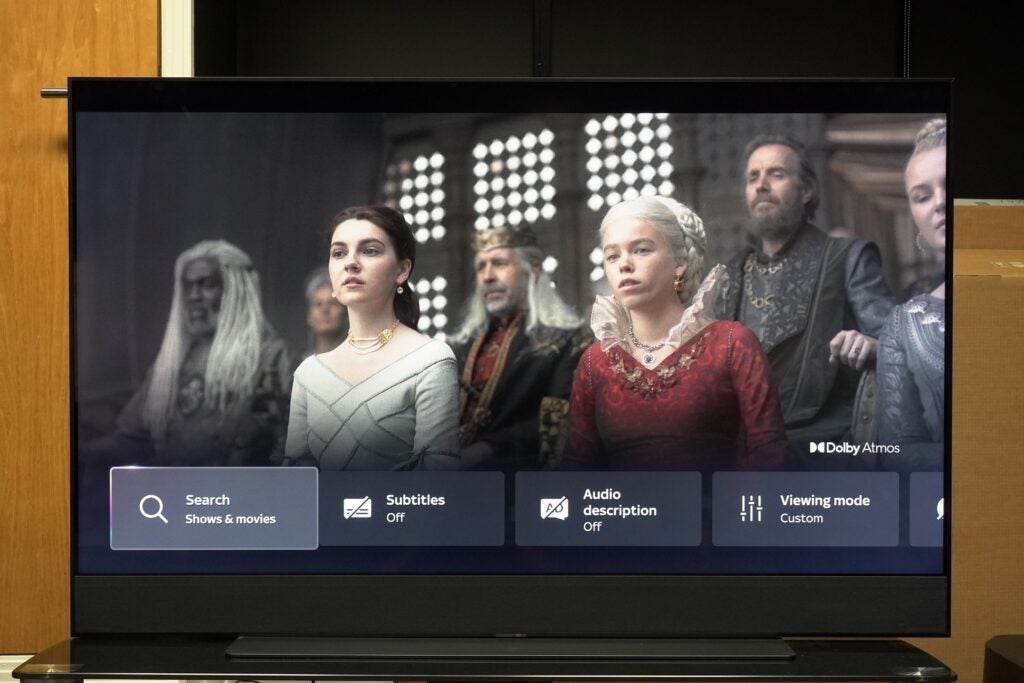
High frequencies have clarity (if not overall sharpness), and bass is punchy though lacks real low-end authority, with impact sounds (punches, gunshots) softly described. Even so, this is a better than most TVs.
And with Atmos there’s a tall reach to the Glass’ sound in Blade Runner 2049 as Spinner cars and futuristic advertisements sit above and around the TV. An Atmos soundbar would evoke better definition, but compared to other TVs around its price, this is an improvement.
Latest deals
Should you buy it?
For Sky customers who want a simplified TV experience, Sky Glass distils the TV experience into a streamlined form in a way that hasn’t been attempted. And it succeeds in some ways but not in all of them.
If you are after best picture and sound If you want the best picture and sound, then Sky Glass hasn’t quite achieved that, but a picture update primed for the end of the year could give Glass the boost it needs in that department.
Final Thoughts
In terms of streamlining the TV experience, there’s plenty to laud about Sky Glass – but there’s a sense that Sky Glass is not quite where it needs to be.
This is not trying to be an OLED or premium QLED, but Glass’ picture doesn’t derive the best from the content Sky has assembled. And while it’s not a premium TV, add everything up and the subscription model still incurs a premium price. A cheaper option is Sky Stream for those who’d prefer to just add a streamer to the existing TV.
Sky Glass doesn’t yet succeed on its goal of unifying content, picture, and sound, but software updates in pipeline look promising and by the beginning of 2023, Sky Glass may well be on its way to fulfilling its potential.
How we test
We test every television we review thoroughly over an extended period of time. We use industry standard tests to compare features properly. We’ll always tell you what we find. We never, ever, accept money to review a product.
Find out more about how we test in our ethics policy.
Tested over the course of several weeks
Tested with real world use
FAQs
Sky says a minimum of 10Mb/s is required for the Glass TV. Minimum download speed for UHD is 25Mb/s.
At its cheapest option, the 43-inch Sky Glass TV plus the Sky Ultimate TV package costs £36/month.
Sustainability
Trusted Reviews’ holds the fact that global warming is not a myth as a core value and will continuously endeavour to help protect our planet from harm in its business practices.
As part of this mission, whenever we review a product we send the company a series of questions to help us gauge and make transparent the impact the device has on the environment.
We currently haven’t received answers to the questions on this product, but will update this page the moment we do. You can see a detailed breakdown of the questions we ask and why in our sustainability info page.
Jargon buster
QLED
QLED stands for Quantum-dot Light Emitting Diode. It’s a display technology that uses small particles (called Quantum Dots) made up of slightly different sizes that produce different wavelengths (colours) when light is shone through them. This filter helps to emit a brighter and wider gamut of colours than a conventional LED TV is capable of.
Dolby Vision
Dolby Vision is a variant of HDR, adding a layer of dynamic metadata to the core HDR signal. This dynamic metadata carries scene-by-scene (or frame-by-frame) instructions from content creators on how a TV should present the images to improve everything from brightness to contrast, detailing and colour reproduction.
4K Ultra HD TV
4K (or Ultra HD) refers to the resolution of a TV’s display, which equates to the number of horizontal and vertical pixels that it can display. 4K TVs have a resolution of 3840 x 2160 (8.3 million pixels), which is four times that of a Full HD TV. With more pixels, you get a sharper, clearer picture than is possible from an equivalent sized 1080p display.
Dolby Atmos
Dolby Atmos is an object-based audio format. It expands on 5.1 and 7.1 soundtracks by adding overhead channels. Sounds are referred to as “audio objects”, of which there can be up to 128 audio channels, and these ‘objects’ can be accurately positioned within a 3D soundscape. This allows soundtracks that support the technology to place sounds above and around the listener with compatible kit.
Consider Sky Glass for what it is rather than what it’s not and there’s a good experience to be had. It’s not a TV for all people, though, a bit pricey for what it is, and the picture quality rather undermines its ambitious content plans.
Pros
- Great content library
- Better sound than TVs at its price
- Stylish looks
- Playlist is a cool idea
Cons
- Not for everyone
- HDR performance is underwhelming
- Subscriptions can build up in price
- Needs plenty of bandwidth for all the features
-
Sky Stream puckTransfers the Glass interface to another screen in the home -
SoundBuilt-in Dolby Atmos speaker system -
HDR supportHLG, HDR10 and Dolby Vision
Introduction
Sky Glass has been out for over a year, and after the hype that greeted its launch, Sky’s first TV has turned out to be one that’s still finding its footing.
It’s a TV designed to be easily digestible, smoothing out the rough edges of the TV buying experience by taking care of picture, sound, and content without need for additional soundbars, set-top boxes or streaming sticks.
But its performance was mixed with an average image quality the sorest issue as the screen failed to take advantage of all the 4K HDR content the Sky platform offered.
Sky have peppered Glass with updates to improve all aspects of its performance. Is it now a better option in 2022 than it was in 2021?
Availability
- UKRRP: £849
- USAunavailable
- Europeunavailable
- Canadaunavailable
- Australiaunavailable
Sky Glass can be purchased directly from Sky in 43-, 55- and 65-inch options. The TV can be bought outright (£649, £849 and £1049); or on a monthly basis in 24- and 48-month instalments.
Prices as of November as low as £11/month + £25 for Sky TV and Netflix on a 48-month contract for the small size.
In terms of add-ons, customers can choose from the Ultra HDR and Atmos package to Sky Sports, Sky Cinema, multi-room, the Sky Stream puck and more. Though the costs rise up even more if you do. You can read more about the packages here.
Design
- Big and heavy
- Minimalist looks
- Several colour options
Viewed from head-on Sky Glass looks elegant. With its minimalist stand, thin bezel trim, anodised finish, and acoustic mesh speaker grille, it has an understated, classy appearance.

Viewed from an angle and the illusion shifts. The Glass is a hefty unit with a depth of 477mm. The 55-inch model weighs 28kg with the stand, so it’s a relief that installation is performed by the courier service. Shift it on your own and you might put your back out and a solid surface to plant this set on is a must.

Irrespective of its dimensions, it has attracted admiring glances from the Trusted Reviews’ team. The review sample is the black Anthracite version, but Sky Glass brings colour to a living room with a choice of Ocean blue, Ceramic white, Racing green and Dusky pink to match your décor.

The speaker grille area can be customised with magnetised attachments, which can be purchased from Amazon seller Concino Limited (£39.99 to £59.99 depending on the size).

On the right-hand side are two buttons, one for disabling the TV’s far-field microphones and another for power. Cast your eyes to the top and there’s a perforated acoustic grille to disperse the sound from the upfiring speakers, while around the rear there’s a stanchion to keep the TV upright. If you want to wall-mount, give Sky a call and they’ll do it for you.
Interface
- Playlist collates saved content
- Easy to use interface
- Sky’s voice control solution
The Entertainment OS, as it’s now dubbed as, aggregates all that Sky has to offer alongside content from other providers. It uses the same rail navigation system as Sky Q, with the top rail offering quick access to recently used apps, inputs and spotlighted content in Top picks.

Below is a rail divided into TV Shows, Movies, Sport, Kids, Audio and Music, News, Fitness and International. Each section has a consistent look with content listed in rows and TV guides TV guides specific to each one. The breadth of content impresses, as does the way it’s been knitted together in a coherent, easy to decipher manner.

Most Sky Q apps make their way over, and while the number of apps is fewer than other TV smart portals, there’s something to be said about quality over quantity. Since Sky Glass launched its added Apple TV+, NBCUniversal’s Peacock, Paramount+ and LionsGate+.

There’s plenty to discover and flicking through the rails with the remote is swift enough in terms of response. If you don’t want to use your digits, there’s built-in voice control that’s initiated by the words ‘Hello Sky’. Initially voice control was flaky, acting like a surly teenager with its lack of responsiveness but it’s become faster and more receptive since launch.
Voice support has been added to YouTube and Netflix so users can speak into the remote to find what they what, with Sky also saying that voice updates will be coming to more apps (although it has stated when and which apps).
Search results have also improved. In the beginning, a search for John Wick also conjured up Escape Route, Danny and Passenger to London – now it’s more specific with John Wick and John Wick: Chapter 2 are the results served up.
Voice commands via the remote’s near-field mic don’t require the ‘Hello Sky’ prompt, and in general, voice control gets you to where you want to go or to what you’re looking for. At a loss for what to watch? Say “What should I watch?” and you’re served rows of recommended content.
The remote itself is a neat affair with a rubbery texture for a grippy hold and backlit buttons for use in the dark. It attracts fingerprints and smudges, but they’re easily wiped off.

Sky refers to its Playlist feature as cloud DVR, but this has caused a degree of consternation as you can’t record content. It works by collating all the content you’ve watched, are watching and plan to watch, and in that context it’s a great way to keep track of shows and films. It’s had a few re-jigs over the year, with movies, TV shows and sports now separated to their own rows.
However, for those who like to keep a permanent file, that’s simply not possible due to rights issues. Once a programme has left Netflix, for example, access to that programme will disappear from your Playlist.

Sky’s counterargument is that nothing truly disappears, instead it migrates to another service but the obvious issue you encounter there is that what if it appears on Prime Video and you don’t have an account? Do viewers want, or have the desire, to create an account for a service they don’t already watch? Would they necessarily want to pay for it on Sky Store when it was part of their subscription on another service? One answer is to simply wait for the programme to come back, but then that puts a few holes into Sky’s seamless approach to aggregating content.
You can’t add content directly from apps so a search must be performed, and you can add there, or if you happen to come across something interesting then a press of the ‘+ button on the remote adds it to your Playlist. It’s nice and straightforward to do.
Add a TV series to Playlist and it’ll string together all the seasons, regardless of the apps it’s spread over and with Sky adding its store if it’s not available elsewhere then the Sky Store can fill the gap.
There are no individual profiles but personalised Playlists for different family members are in the offing so you can view what you want rather than have to filter through your kid’s tastes. Currently the home page refreshes content six times a day. If a child watches in the morning, and a parent at night, it’ll reflect those times in the programming served up.
Sky has brought its accessibility features over to Glass, incorporating the High Contrast interface, Audio description and highlighting of content in the TV Guide for easier recognition.

Features
- Not for gamers
- Minimum 10Mb/s for streaming
- Stream puck copies interface to other screens
There are things that Sky Glass is, and things that it’s not – and it’s not a gaming TV. With no game mode, latency is a measly 66ms and with no Auto Low Latency Mode, 4K/120fps or Variable Refresh Rate, Sky Glass isn’t looking to play in that gaming sandpit.
The three HDMI inputs support the HDMI 2.1 spec, with HDMI 2 the eARC port for pass-through of higher quality audio to an external sound system. As Sky Glass has a built-in Atmos sound system, you could leave it at that if you wanted.

Other connections include USB-C, Ethernet, and a DTT DVB-T/T2 aerial. That offers basic Freeview and acts as a backup in case the Internet goes down. There’s Bluetooth 5.0 (for the remote, general Bluetooth connectivity is arriving soon) and Wi-Fi 6. Sky Glass requires a minimum speed of 10Mb/s (25Mb/s for 4K Ultra HD).
During start-up you’re given a choice of Default or Enhanced experiences. Enhanced activates voice control and the instant wake-up features, so the TV can be turned on via voice or by shuffling past, though the latter feature is not the most consistent in behaviour.

More times than I can count I’ve walked past, and nothing has happened. Other times I’ve absentmindedly walked by to find it’s woken up. Waking it with your voice is more consistent and since launch has become quicker in the time it takes to boot.
I wasn’t supplied with the Sky Stream puck for review but that works independently of Glass and is now available to buy as a standalone device fi you have an existing TV and just want to stream content from Sky. Stream uses around 15Mb/s to stream content within the home.
Picture Quality
- Underwhelming HDR performance
- Lacks brightness
- Lacklustre viewing angles
Picture quality from Sky Glass is no disaster – it’s simply fine – but it’s not unreasonable to expect better.
The HDR performance suffers from a lack of brightness, with the 55-inch model producing a peak luminance of 430 nits, which is not quite at the level needed to realise the potential of HDR. Highlights – the brightest part of the image – are dimly rendered whether in HDR10 or Dolby Vision.

While watching A 4K Dolby Vision presentation of John Wick: Chapter 3 – Parabellum, the scene where Wick faces off against two shinobi assassins depicts contrast that’s mildly described and a picture somewhat two-dimensional in scope. Watching Netflix, even the lights in the background of Seinfeld’s stand-up sets lack brightness.
Dolby Vision Bright mode ekes out more brightness, while the Dark profile provides better blacks. But even with Dolby Vision, when Wick visits Angelica Huston’s The Director, there’s visible blooming.

Watching House of the Dragon and black levels lack much in terms of depth, colours appear washed out and while there’s some three-dimensional depth to some images from the first episode of the season, the lack of contrast and richness to the colours make for an underwhelming experience.

More brightness can be found by turning off the light sensor, but it’s disappointing to resort to that. I’m not all that convinced by Sky’s Intelligent Zonal Technology’ local dimming system as it seems to have little impact. Apparently, it’s been updated to be more aggressive, but there’s not much brightness to emphasise contrast.
For a Quantum Dot panel, there’s a surprising lack of punchiness, saturation and expressiveness to HDR colours. When Luv visits Wallace in Blade Runner 2049, the orange glow of his chamber is wanly described, the colour gradations lack finesse. Fine tuning is required to get more out of the image.

A watch of Spurs against United in 4K HLG HDR, and though colours are firmer and more naturally conveyed than the HD presentation, the whites of the Spurs’ player shirts lacked the gleam and brightness I’d expect. Sky has released an update to boost HLG brightness, but overall, there’s a reserved feel to this TV’s HDR skills.
A strength of LCD TVs is dark detail and Sky Glass handles that aspect well enough for a revealing picture, though this is more apparent with brighter images. Black uniformity is fine, avoiding a washed-out appearance and ascribing a decent level of depth. However, with every bit of praise there’s a caveat. Viewing angles are average and it doesn’t take a big shift off-axis to reveal washed out colours and blooming, not helped by TV not dealing particularly well with reflections and glare from within a room.

HD streaming is decent, but like the story of Sky Glass’ picture, it’s up and down. At times sharp and clear enough to pick out fine detail, in others it produces a softness to faces, as well as hardness and shininess to edges that distracts. Reducing sharpness helps but finding a middle ground is tricky. Motion handling isn’t the most adept either, with a slight blurriness noticeable even when people turn their heads
The content on Sky Glass is great, but its picture performance does not wring the best out of it. There is an update that looks to have fixed some (but not all) of its issues. Expect that to arrive before the end of 2022.
Sound Quality
- Decent, punchy bass for a TV
- Polite impression of height channels
- A soundbar would offer better focus
The audio system derives more enjoyment. The first sample had a faulty woofer that caused distortion with the mildest of low-end frequencies, but the replacement was free from issues.
Sky Glass’ 215W Dolby Atmos system is made up of six speakers: three that fire towards the listener, two that fire up and a woofer for the low frequencies. It’s an improvement over TVs in its price bracket, putting in a solid, weighty, and spacious presentation. Is it better than a budget soundbar? No, but this 2.1 system will suffice for the less demanding.

Vocals are emphasised, though not quite naturally, especially when two voices speak at once. Pump up the volume and voices have a sharp sense of tone but avoid sibilance. The effect of the Enhance Speech Quality setting is most evident on Sky content, with voices more prominent but the naturalness of the delivery a little stifled.
Effects are steered across the screen well, creating a soundfield that spreads beyond the TV’s four corners. The scene in Tenet where The Protagonist is interrogated in a train yard as the trains creak past and the width of the soundstage is effectively expanded beyond the TV’s borders.

High frequencies have clarity (if not overall sharpness), and bass is punchy though lacks real low-end authority, with impact sounds (punches, gunshots) softly described. Even so, this is a better than most TVs.
And with Atmos there’s a tall reach to the Glass’ sound in Blade Runner 2049 as Spinner cars and futuristic advertisements sit above and around the TV. An Atmos soundbar would evoke better definition, but compared to other TVs around its price, this is an improvement.
Latest deals
Should you buy it?
For Sky customers who want a simplified TV experience, Sky Glass distils the TV experience into a streamlined form in a way that hasn’t been attempted. And it succeeds in some ways but not in all of them.
If you are after best picture and sound If you want the best picture and sound, then Sky Glass hasn’t quite achieved that, but a picture update primed for the end of the year could give Glass the boost it needs in that department.
Final Thoughts
In terms of streamlining the TV experience, there’s plenty to laud about Sky Glass – but there’s a sense that Sky Glass is not quite where it needs to be.
This is not trying to be an OLED or premium QLED, but Glass’ picture doesn’t derive the best from the content Sky has assembled. And while it’s not a premium TV, add everything up and the subscription model still incurs a premium price. A cheaper option is Sky Stream for those who’d prefer to just add a streamer to the existing TV.
Sky Glass doesn’t yet succeed on its goal of unifying content, picture, and sound, but software updates in pipeline look promising and by the beginning of 2023, Sky Glass may well be on its way to fulfilling its potential.
How we test
We test every television we review thoroughly over an extended period of time. We use industry standard tests to compare features properly. We’ll always tell you what we find. We never, ever, accept money to review a product.
Find out more about how we test in our ethics policy.
Tested over the course of several weeks
Tested with real world use
FAQs
Sky says a minimum of 10Mb/s is required for the Glass TV. Minimum download speed for UHD is 25Mb/s.
At its cheapest option, the 43-inch Sky Glass TV plus the Sky Ultimate TV package costs £36/month.
Sustainability
Trusted Reviews’ holds the fact that global warming is not a myth as a core value and will continuously endeavour to help protect our planet from harm in its business practices.
As part of this mission, whenever we review a product we send the company a series of questions to help us gauge and make transparent the impact the device has on the environment.
We currently haven’t received answers to the questions on this product, but will update this page the moment we do. You can see a detailed breakdown of the questions we ask and why in our sustainability info page.
Jargon buster
QLED
QLED stands for Quantum-dot Light Emitting Diode. It’s a display technology that uses small particles (called Quantum Dots) made up of slightly different sizes that produce different wavelengths (colours) when light is shone through them. This filter helps to emit a brighter and wider gamut of colours than a conventional LED TV is capable of.
Dolby Vision
Dolby Vision is a variant of HDR, adding a layer of dynamic metadata to the core HDR signal. This dynamic metadata carries scene-by-scene (or frame-by-frame) instructions from content creators on how a TV should present the images to improve everything from brightness to contrast, detailing and colour reproduction.
4K Ultra HD TV
4K (or Ultra HD) refers to the resolution of a TV’s display, which equates to the number of horizontal and vertical pixels that it can display. 4K TVs have a resolution of 3840 x 2160 (8.3 million pixels), which is four times that of a Full HD TV. With more pixels, you get a sharper, clearer picture than is possible from an equivalent sized 1080p display.
Dolby Atmos
Dolby Atmos is an object-based audio format. It expands on 5.1 and 7.1 soundtracks by adding overhead channels. Sounds are referred to as “audio objects”, of which there can be up to 128 audio channels, and these ‘objects’ can be accurately positioned within a 3D soundscape. This allows soundtracks that support the technology to place sounds above and around the listener with compatible kit.



